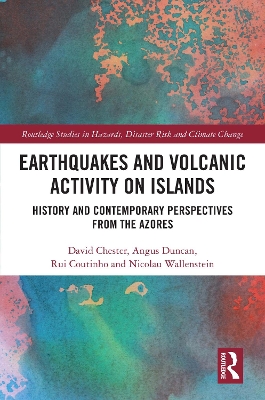Routledge Studies in Hazards, Disaster Risk and Climate Change
2 total works
Earthquakes and Volcanic Activity on Islands
by David K. Chester, Angus Duncan, Rui Coutinho, and Nicolau Wallenstein
This volume examines the impact of and responses to historic earthquakes and volcanic eruptions in the Azores. Study is placed in the contexts of: the history and geography of this fascinating archipelago; progress being made in predicting future events and policies of disaster risk reduction.
This is the only volume to consider the earthquake and volcanic histories of the Azores across the whole archipelago and is based, not only on contemporary published research, but also on the detailed study of archival source materials. The authors seek to show how extreme environmental events, as expressed through eruptions, earthquakes and related processes operating in the past may be considered using both complementary scientific and social scientific perspectives in order to reveal the ways in which Azorean society has been shaped by both an isolated location in the middle of the Atlantic Ocean and the ever present threat of environmental uncertainty. Chapter 2, which analyses in depth the geology and tectonics of the islands is of more specialist interest, but technical terms are fully explained so as to widen the accessibility of this material.
The audience for this volume includes all those who are interested in the geology, geography, history and hazard responses in the Azores. It is written, not just for the educated general reader, but for the specialist earth scientist and hazard researcher.
Religious Responses to Earthquake and Volcanic Eruption Disasters
by David Chester, Angus Duncan, and John Duncan
This book argues that, although secular and religious perspectives on disasters have often conflicted, today there are grounds for believing that the world’s major faiths have much to contribute to the processes of post-disaster recovery and future disaster risk reduction (DRR).
It seeks to demonstrate how contemporary dialogues between theologians, disaster scholars and policymakers are defining new ways. These ways explore the resources of religious communities e.g. buildings, human resources and finance may be used to foster successful policies of disaster risk reduction, particularly in the aftermath of earthquakes and volcanic eruptions. Musing on the relationships between religion and disasters has occurred for millennia and has affected many societies worldwide. In societies where the world’s major religions - Buddhism, Christianity, Hinduism, Islam, Judaism and Shinto - have been and remain dominant, attempting to find supernatural explanations for disasters has occurred throughout history and there have been many theologies seeking to explain why people suffer losses. It is argued that developments both within these traditions of faith and in how disasters are understood by the hazard research community of researchers and planners has allowed a new modus vivendi to emerge which emphasises both a recognition of religious worldviews by academic writers and disaster planners on the one hand, and a desire by people of faith and their leaders to be more fully committed to the goals of disaster risk reduction (DRR).
The book will appeal to those who are interested in the interface between disasters and theology across the principal religions of the world. This includes researchers and students in geology, geography, theology and religious studies. It will also be useful for specialist academic audience and the educated general reader.

